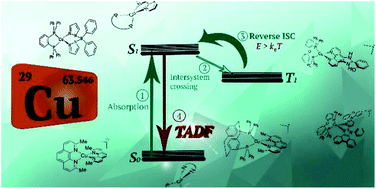Thermally activated delayed fluorescence in luminescent cationic copper(i) complexes
Abstract
In this work, the photophysical characteristics of [Cu(N^N)2]+ and [Cu(N^N)(P^P)]+ complexes were described. The concept of thermally activated delayed fluorescence (TADF) and its development throughout the years was also explained. The importance of ΔE(S1–T1) and spin-orbital coupling (SOC) values on the TADF behavior of [Cu(N^N)2]+ and [Cu(N^N)(P^P)]+ complexes is discussed. Examples of ΔE(S1–T1) values reported in the literature were collected and some trends were proposed (e.g. the effect of the substituents at the 2,9 positions of the phenanthroline ligand). Besides, the techniques (or calculation methods) used for determining ΔE(S1–T1) values were described. The effect of SOC in TADF was also discussed, and examples of the determination of SOC values by DFT and TD-DFT calculations are provided. The last chapter covers the applications of [Cu(N^N)2]+ and [Cu(N^N)(P^P)]+ TADF complexes and the challenges that are still needed to be addressed to ensure the industrial applications of these compounds.



 Please wait while we load your content...
Please wait while we load your content...